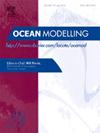Mechanism of suspended sediment variation during a landing typhoon in the Yangtze River Estuary
IF 2.9
3区 地球科学
Q2 METEOROLOGY & ATMOSPHERIC SCIENCES
引用次数: 0
Abstract
Hydrodynamic variations and suspended sediment concentration (SSC) dynamics under typhoon conditions are critical to understanding sediment transport processes in the Yangtze River Estuary (YRE). Strong winds, waves, and currents during typhoons alter water levels, flow velocities, and SSC distribution patterns, significantly affecting estuarine stratification. This study employs a validated three-dimensional coupled hydrodynamic-salinity-sediment transport model integrated with wave dynamics to investigate storm surge characteristics and SSC variations during Typhoon Muifa (September 2022). The mechanisms driving SSC changes were analyzed through wave effects and bottom shear stress (BSS). Key findings include: 1) Storm surge evolution during Typhoon Muifa transitioned from positive to negative storm surge due to the typhoon's southeast-to-northwest path, with a declining trend post-landfall. 2) Peak BSS values at NC2 (outer North Channel) reached 9.0 Pa, five times higher than normal conditions, while the maximum bottom-layer SSC at NB2 (outer North Branch) exceeded 15 kg/m³. 3) Nonlinear wave-current interactions modulated BSS magnitudes and SSC distribution. These interactions enhanced BSS in outer estuarine regions, suppressed tidal forces, and promoted sediment deposition, ultimately reducing SSC across all study sites. The results highlight distinct SSC responses to typhoon-induced dynamics, underscoring the need for further research on wave-sediment interaction mechanisms.
长江口登陆台风期间悬沙变化机制
台风条件下长江口水动力变化和悬沙浓度(SSC)动态变化是了解长江口输沙过程的关键。台风期间的强风、海浪和海流改变了水位、流速和南海温分布模式,显著影响了河口分层。本研究采用经过验证的三维水动力-盐-沙耦合模型,结合波浪动力学,研究了台风“梅法”(2022年9月)期间的风暴潮特征和SSC变化。通过波浪效应和底部剪切应力(BSS)分析了驱动SSC变化的机制。主要发现包括:1)台风“梅法”期间风暴潮演化受台风东南向西北路径影响,由正风暴潮向负风暴潮过渡,登陆后风暴潮演化趋势减弱;(2) NC2(北外支路)的最大BSS值达到9.0 Pa,是正常条件下的5倍,而NB2(北外支路)的最大底层SSC超过15 kg/m³。3)非线性波流相互作用调制了BSS振幅和SSC分布。这些相互作用增强了河口外区域的BSS,抑制了潮汐力,促进了沉积物沉积,最终减少了所有研究地点的SSC。研究结果强调了南海对台风动力的不同响应,强调了波浪-沉积物相互作用机制的进一步研究的必要性。
本文章由计算机程序翻译,如有差异,请以英文原文为准。
求助全文
约1分钟内获得全文
求助全文
来源期刊

Ocean Modelling
地学-海洋学
CiteScore
5.50
自引率
9.40%
发文量
86
审稿时长
19.6 weeks
期刊介绍:
The main objective of Ocean Modelling is to provide rapid communication between those interested in ocean modelling, whether through direct observation, or through analytical, numerical or laboratory models, and including interactions between physical and biogeochemical or biological phenomena. Because of the intimate links between ocean and atmosphere, involvement of scientists interested in influences of either medium on the other is welcome. The journal has a wide scope and includes ocean-atmosphere interaction in various forms as well as pure ocean results. In addition to primary peer-reviewed papers, the journal provides review papers, preliminary communications, and discussions.
 求助内容:
求助内容: 应助结果提醒方式:
应助结果提醒方式:


